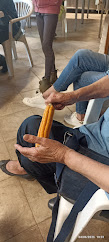4.06.2025
DAILY DIARY
“C’È SEMPRE DA IMPARARE”
Recentemente
alcune amiche mi hanno chiesto,
“Emma ma te sai
cosè il granturco a 8 file?”. Quella domanda mi mise in difficultà.
“No, non lo
conosco”, risposi timidamente sentendomi ignorante in materia.
Mi difendo e
dico, “non conosco niente di agricoltura. I miei genitori hanno sempre lavorato
in fabbrica, mia Mamma era operaia di un’azienda tessile mentre mio Babbo fece
esperienze in diversi lavori e tra questi anche nella fabbrica metallurgica. A
mia volta anch’io sono stata dipendente in una fabbrica tessile per 40 anni, e
certamente questa lavorazione non c’entrava proprio niente con i campi di grano”.
Recentemente sui social è apparso un invito di un corso rivolto agli anziani, un campo estivo presso un noto Podere, dove presentano proprio una lezione sul “granturco a 8 file”. Perfetto, ho pensato, è proprio quello che mi ci vuole. La curiosità mi ha spinto a partecipare.
 |
| GRANTURCO 8 FILE |
Ascoltavo
con grande interesse mentre gli esperti descrivevano l’origine del grano, le
tecniche di semina e raccolta.
Non c’è che
dire il lavoro del contadino è davvero faticoso.
Era una bella giornata di sole, e dopo la lezione di teoria siamo usciti volentieri nel Podere per vedere dal vivo il campo seminato, con le piantine ancora timide.
Appena fuori
tra le piante di susine, ciliegie, e frutti di bosco in un recinto c’erano
anche 4 asinelli che aspettavano la nostra attenzione.
Gli attrezzi dell’agricoltore erano a portata di mano, ed anch’io ho provato ad arare intorno alle piccole piantine appena nate. Certo, per me era solo un gioco, ma chi lo fa di mestiere è un lavoro “duro” e impegnativo.
Nella mia
famiglia la farina di granturco è molto usato e le ricette mettono sempre tutti
d’accordo. Oltre alla polenta con i suoi vari contorni, una specialità del mio
paese sono i “mignecci”, una specie di “crisciolette” che si cuociono nei cosìddetti
“testi”.
Questa è una
ricetta tradizional che può essere preparata a secondo dei gusti.
L’impasto è
molto semplice.
C’è a chi le
preferisce fatti totalmente di farina di granturco, amalgamato con l’acqua,
sale e un filo d’olio. Ma l’impasto può anche essere preparato mescolando metà dose
di granturco e metà di farina di grano.
…ma
l’ingrediente che li rende ancora più appetitoso è l’aggiunta di fettine di
pancetta, sistemate sopra mentre cuociono.
PROVATE PER
CREDERE!!!
“THERE IS ALWAYS MORE TO LEARN”
Recently some friends asked me,
“Emma, do you know what 8-row corn is?”.
That question put me in difficulty.
“No, I don’t know,” I replied timidly,
feeling ignorant on the subject.
I defended myself and said, “I don’t know
anything about agriculture. My parents have always worked in factories, my
mother was a worker in a textile company while my father gained experience in
various jobs, including in a metallurgical factory. I, too, was an employee in
a textile factory for 40 years, and this work certainly had nothing to do with
the corn fields.”
Recently, an invitation to a course aimed
at the elderly, appeared on social media, a summer camp at a well-known farm,
where they present a lesson on “8-row corn.” Perfect, I thought, that’s just
what I need. Curiosity pushed me to participate.
At the first meeting, most of the
participants knew the work of the farmer, telling memories and experiences
lived in the fields during their childhood. I, on the other hand, had nothing
to tell!
I listened with great interest while the
experts described the origin of the wheat, the sowing and harvesting
techniques.
There is no denying that the work of the
farmer is really hard.
It was a beautiful sunny day, and after the theory lesson we gladly went out to see the sown field to see the shy growing of the plants.
Just outside among the plum, cherry and
berry trees in a pen there were also 4 donkeys waiting for our attention.
The farmer's tools were at hand, and I also
tried to plow around the small newly born seedlings. Of course, for me it was
just a game, but for those who do it professionally it is a "hard"
and demanding job.
In my family, corn flour is used a lot and
the recipes always satisfy everyone. In addition to polenta with its various
side dishes, a specialty of my country is the "mignecci", a kind of
"crisciolette" that are cooked in the so-called "testi".
This is a traditional recipe that can be
prepared according to taste.
The dough is very simple.
There are those who prefer them made
entirely of corn flour, mixed with water, salt and a drizzle of oil. But the
dough can also be prepared by mixing half the amount of corn and half of wheat
flour.
...but the ingredient that makes them even
more appetizing is the addition of slices of bacon, placed on top while they
cook.
TRY IT TO BELIEVE!!!












WOW !!!
RispondiEliminaEmma un lavoro eccezionale sul tema di ieri al podere, la musica emozionante. Grazie.🌽
RispondiEliminaPieranna vieni anche te al prossimo incontro, vedrai come si sta bene al Podere.!!!
RispondiEliminaGrazie Rita, per il tuo commento. Ci vedremo al Podere al prossimo incontro!!!
RispondiElimina